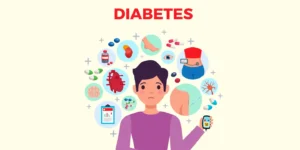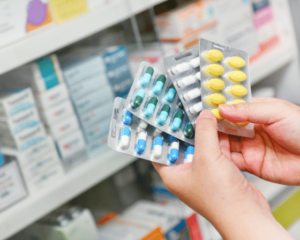Living with diabetes requires consistent management and vigilance to maintain blood sugar levels within a healthy range. However, despite best efforts, individuals may encounter periods of uncontrolled diabetes. Uncontrolled diabetes poses serious health risks and requires prompt intervention. In this article, we’ll explore the treatment strategies and considerations for managing uncontrolled diabetes effectively.
Contents
What is Uncontrolled Diabetes?

Uncontrolled diabetes refers to a condition where blood glucose levels remain consistently elevated despite efforts to manage them through medication, diet, and lifestyle modifications. In other words, it’s a situation where the individual’s diabetes is not well-regulated, leading to persistently high blood sugar levels.
Several factors can contribute to uncontrolled diabetes:
- Medication Non-Adherence: Not taking diabetes medications as prescribed or skipping doses can lead to uncontrolled blood sugar levels.
- Inadequate Insulin Dosage: For individuals with type 1 diabetes or advanced type 2 diabetes, not taking enough insulin or other glucose-lowering medications can result in elevated blood sugar levels.
- Dietary Indiscretions: Consuming excessive amounts of carbohydrates, sugary foods, or large meals can cause blood sugar spikes, especially if not balanced with insulin or medication.
- Stress: Stress hormones can raise blood sugar levels, making it challenging to control diabetes during stressful periods.
- Illness or Infection: Infections or illnesses can cause blood sugar levels to rise due to the body’s inflammatory response and increased insulin resistance.
- Underlying Medical Conditions: Certain medical conditions, such as hormonal disorders or untreated sleep apnea, can affect blood sugar regulation and contribute to uncontrolled diabetes.
- Insufficient Physical Activity: Lack of regular exercise can reduce insulin sensitivity and make it harder to control blood sugar levels.
- Insufficient Monitoring: Not regularly monitoring blood sugar levels or not adjusting treatment plans based on monitoring results can lead to uncontrolled diabetes.
Health Risks of Uncontrolled Diabetes
Uncontrolled diabetes can have serious health consequences, leading to various complications and significantly impacting overall well-being. Here are some of the key health risks associated with uncontrolled diabetes:
- Cardiovascular Disease: Uncontrolled diabetes is a major risk factor for cardiovascular problems such as heart disease, heart attack, and stroke. Elevated blood sugar levels can damage blood vessels and nerves that control the heart and blood vessels, increasing the risk of atherosclerosis (hardening and narrowing of the arteries) and other heart-related complications.
- Neuropathy: Prolonged exposure to high blood sugar levels can damage nerves throughout the body, leading to diabetic neuropathy. This condition can cause symptoms such as numbness, tingling, burning sensations, and pain, particularly in the hands and feet. Neuropathy can also affect other organs and systems, leading to digestive issues, sexual dysfunction, and urinary problems.
- Nephropathy: Diabetes is the leading cause of kidney disease (diabetic nephropathy), which can progress to kidney failure if left untreated. High blood sugar levels can damage the small blood vessels in the kidneys, impairing their ability to filter waste and excess fluids from the blood effectively. This can lead to the accumulation of toxins and fluid retention, resulting in high blood pressure, electrolyte imbalances, and eventually kidney failure.
Types of Uncontrolled Diabetes Treatment Options
The first step in managing uncontrolled diabetes is to consult with a healthcare provider, preferably a diabetes specialist. The healthcare provider will assess the individual’s current condition, identify potential causes of uncontrolled diabetes, and tailor a treatment plan accordingly.
Here are some treatment methods:
Medication Adjustment

Medications play a crucial role in achieving glycemic control, improving quality of life, and reducing the risk of long-term complications associated with uncontrolled diabetes. Here’s an overview of the different types of medications commonly used in the treatment of uncontrolled diabetes:
Oral Medications
Metformin: Metformin is usually the first-line oral medication for type 2 diabetes. It works by reducing glucose production in the liver and improving insulin sensitivity in peripheral tissues.
Sulfonylureas: Sulfonylureas stimulate the pancreas to release more insulin. They help lower blood sugar levels by increasing insulin secretion.
DPP-4 Inhibitors: DPP-4 inhibitors work by preventing the breakdown of incretin hormones, which stimulate insulin release and reduce glucagon secretion, resulting in lower blood sugar levels.
SGLT2 Inhibitors: SGLT2 inhibitors block the reabsorption of glucose by the kidneys, leading to increased glucose excretion in the urine and lower blood sugar levels.
GLP-1 Receptor Agonists: GLP-1 receptor agonists mimic the action of incretin hormones, stimulating insulin release, suppressing glucagon secretion, slowing gastric emptying, and promoting satiety.
Injectable Medications
Insulin Therapy: Insulin therapy is essential for individuals with type 1 diabetes and often required for those with advanced type 2 diabetes. Insulin helps lower blood sugar levels by facilitating glucose uptake into cells, inhibiting glucose production in the liver, and suppressing glucagon secretion.
GLP-1 Receptor Agonists: In addition to oral formulations, GLP-1 receptor agonists are available as injectable medications. They offer the benefits of improved glycemic control, weight loss, and cardiovascular risk reduction.
Dietary Modifications

Here’s a comprehensive overview of dietary modifications as a treatment strategy for uncontrolled diabetes:
1. Carbohydrate Management
- Monitoring Carbohydrate Intake: Individuals with uncontrolled diabetes should monitor their carbohydrate intake to prevent spikes in blood sugar levels. This involves counting carbohydrates and choosing carbohydrate sources that have a minimal impact on blood glucose, such as whole grains, legumes, vegetables, and fruits with a low glycemic index.
- Portion Control: Controlling portion sizes is essential for managing blood sugar levels. Eating smaller, balanced meals throughout the day can help prevent large fluctuations in blood glucose and promote more stable insulin responses.
2. Emphasis on Whole Foods
- Whole Grains: Whole grains, such as brown rice, quinoa, oats, and whole wheat bread, are rich in fiber and nutrients and have a lower glycemic index compared to refined grains. They help regulate blood sugar levels and promote satiety.
- Fruits and Vegetables: Non-starchy vegetables and low-sugar fruits, such as leafy greens, broccoli, berries, and citrus fruits, are excellent choices for individuals with uncontrolled diabetes. They provide essential vitamins, minerals, and antioxidants while contributing minimal carbohydrates and calories.
3. Protein-Rich Foods
- Lean Protein Sources: Incorporating lean protein sources into meals helps stabilize blood sugar levels and promote feelings of fullness. Examples include poultry, fish, tofu, legumes, and low-fat dairy products.
- Plant-Based Proteins: Plant-based protein sources, such as beans, lentils, chickpeas, and nuts, are rich in fiber and have a minimal impact on blood glucose levels. They are suitable alternatives for individuals following vegetarian or vegan diets.
4. Healthy Fats
- Monounsaturated and Polyunsaturated Fats: Foods rich in monounsaturated and polyunsaturated fats, such as avocados, olive oil, nuts, seeds, and fatty fish, can help improve insulin sensitivity and reduce the risk of cardiovascular complications associated with uncontrolled diabetes.
- Limiting Saturated and Trans Fats: Minimizing the intake of saturated and trans fats, found in red meat, full-fat dairy products, fried foods, and processed snacks, is important for managing cholesterol levels and reducing the risk of heart disease.
Regular Physical Activity
Regular exercise can improve insulin sensitivity and help regulate blood sugar levels. Healthcare providers may recommend incorporating a combination of aerobic exercise, strength training, and flexibility exercises into the individual’s routine. However, exercise plans should be tailored to the individual’s fitness level and health status.
- Aerobic Exercise: Activities such as walking, jogging, cycling, swimming, dancing, and aerobic classes increase heart rate and breathing rate, improving cardiovascular fitness and burning calories.
- Strength Training: Resistance exercises using weights, resistance bands, or body weight help build muscle mass, increase metabolism, and improve insulin sensitivity. Strength training should be incorporated into the exercise routine at least two days per week.
- Flexibility and Balance Exercises: Stretching exercises, yoga, tai chi, and balance exercises improve flexibility, range of motion, and stability, reducing the risk of falls and injuries, especially in older adults with diabetes.
Developing a Safe and Effective Exercise Plan:
- Before starting an exercise program, individuals with uncontrolled diabetes should consult with their healthcare provider to assess their health status, identify any potential contraindications or precautions, and develop a personalized exercise plan tailored to their needs and abilities.
- Gradual progression is key to preventing injuries and avoiding complications. Starting with low-intensity activities and gradually increasing the duration, frequency, and intensity of exercise over time allows the body to adapt and minimize the risk of overexertion.
Continuous Glucose Monitoring (CGM)
CGM systems offer continuous monitoring of glucose levels throughout the day and night, offering valuable insights into glucose trends, patterns, and fluctuations that may not be captured by traditional fingerstick blood glucose monitoring. Here’s a detailed exploration of CGM as a treatment strategy for uncontrolled diabetes:
1. Real-Time Glucose Monitoring: CGM systems continuously measure glucose levels in the interstitial fluid beneath the skin, providing real-time data on blood sugar levels without the need for frequent fingerstick blood tests. This allows individuals with uncontrolled diabetes to monitor their glucose levels more frequently and make timely adjustments to their treatment regimen.
2. Early Detection of Hyperglycemia and Hypoglycemia: CGM systems provide alerts and alarms when blood sugar levels are outside the target range, helping individuals with uncontrolled diabetes detect and respond to hyperglycemia (high blood sugar) or hypoglycemia (low blood sugar) before they become severe. This early detection can prevent complications and improve overall glycemic control.
Stress Management and Mental Health Support

- Mindfulness Meditation: Mindfulness meditation involves focusing attention on the present moment without judgment, helping individuals with uncontrolled diabetes reduce stress, anxiety, and negative emotions associated with diabetes management.
- Deep Breathing Exercises: Deep breathing exercises promote relaxation, reduce stress, and lower cortisol levels. Incorporating deep breathing exercises into daily routines can help individuals with uncontrolled diabetes manage stress and improve glycemic control.
- Progressive Muscle Relaxation: Progressive muscle relaxation involves systematically tensing and relaxing different muscle groups to release physical tension and reduce stress. Practicing progressive muscle relaxation regularly can help individuals with uncontrolled diabetes alleviate stress-related symptoms and promote relaxation.
- Yoga and Tai Chi: Yoga and tai chi are mind-body practices that combine physical postures, breathing techniques, and meditation to promote relaxation, reduce stress, and improve overall well-being. Regular practice of yoga and tai chi can benefit individuals with uncontrolled diabetes by reducing stress levels and improving glycemic control.
- Cognitive-Behavioral Therapy (CBT): Cognitive-behavioral therapy (CBT) is an evidence-based psychotherapy approach that helps individuals with uncontrolled diabetes identify and challenge negative thought patterns, develop coping strategies, and change behaviors that contribute to stress and poor diabetes management. CBT can be effective in reducing stress, anxiety, and depression, and improving diabetes self-care behaviors.
Conclusion
Uncontrolled diabetes poses significant health risks and requires prompt intervention to prevent complications. By working closely with healthcare providers, making necessary lifestyle modifications, and adhering to prescribed treatment plans, individuals with diabetes can achieve better blood sugar control and improve their overall quality of life.
With a comprehensive approach that addresses medication management, dietary considerations, physical activity, and emotional well-being, uncontrolled diabetes can be effectively managed, reducing the risk of long-term complications and optimizing health outcomes.
Do you want to get rid of diabetes? Join our online diabetes treatment program and reverse Diabetes naturally through lifestyle changes such as a Personalized Diet plan, Exercise, Yoga, dieticians, and health coaches.

